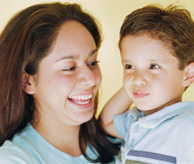
Diagnosis
In this section, we cover a number of different issues that surround the diagnosis of autism. Although there are many concerns about labeling a young child with an ASD, the earlier the diagnosis of ASD is made, the earlier needed interventions can begin. Evidence over the last 15 years indicates that intensive early intervention in optimal educational settings for at least 2 years during the preschool years results in improved outcomes in most young children with ASD.
In evaluating a child, clinicians rely on behavioral characteristics to make a diagnosis. Some of the characteristic behaviors of ASD may be apparent in the first few months of a child's life, or they may appear at any time during the early years. For the diagnosis, problems in at least one of the areas of communication, socialization, or restricted behavior must be present before the age of 3. The diagnosis requires a two-stage process. The first stage involves developmental screening during "well child" check-ups; the second stage entails a comprehensive evaluation by a multidisciplinary team.
Problems That May Accompany ASD
Sensory problems. When children's perceptions are accurate, they can learn from what they see, feel, or hear. On the other hand, if sensory information is faulty, the child's experiences of the world can be confusing. Many ASD children are highly attuned or even painfully sensitive to certain sounds, textures, tastes, and smells. Some children find the feel of clothes touching their skin almost unbearable. Some sounds—a vacuum cleaner, a ringing telephone, a sudden storm, even the sound of waves lapping the shoreline—will cause these children to cover their ears and scream.
In ASD, the brain seems unable to balance the senses appropriately. Some ASD children are oblivious to extreme cold or pain. An ASD child may fall and break an arm, yet never cry. Another may bash his head against a wall and not wince, but a light touch may make the child scream with alarm.
Mental retardation. Many children with ASD have some degree of mental impairment. When tested, some areas of ability may be normal, while others may be especially weak. For example, a child with ASD may do well on the parts of the test that measure visual skills but earn low scores on the language subtests.
Seizures. One in four children with ASD develops seizures, often starting either in early childhood or adolescence. 5 Seizures, caused by abnormal electrical activity in the brain, can produce a temporary loss of consciousness (a "blackout"), a body convulsion, unusual movements, or staring spells. Sometimes a contributing factor is a lack of sleep or a high fever. An EEG (electroencephalogram—recording of the electric currents developed in the brain by means of electrodes applied to the scalp) can help confirm the seizure's presence.
In most cases, seizures can be controlled by a number of medicines called "anticonvulsants." The dosage of the medication is adjusted carefully so that the least possible amount of medication will be used to be effective.
Fragile X syndrome. This disorder is the most common inherited form of mental retardation. It was so named because one part of the X chromosome has a defective piece that appears pinched and fragile when under a microscope. Fragile X syndrome affects about two to five percent of people with ASD. It is important to have a child with ASD checked for Fragile X, especially if the parents are considering having another child. For an unknown reason, if a child with ASD also has Fragile X, there is a one-in-two chance that boys born to the same parents will have the syndrome. 6 Other members of the family who may be contemplating having a child may also wish to be checked for the syndrome.
Tuberous Sclerosis. Tuberous sclerosis is a rare genetic disorder that causes benign tumors to grow in the brain as well as in other vital organs. It has a consistently strong association with ASD. One to 4 percent of people with ASD also have tuberous sclerosis.
NIMH

